August 2012
The Karaoke did us in...
Central Sweden & Southern Finland
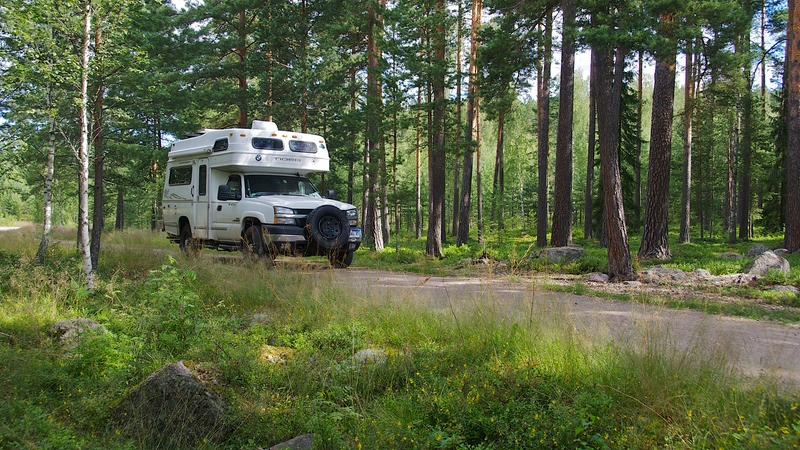
So… where were we? Oh, yes, we’d been making our way south from the far north, down the middle of Sweden. After some final out-in-the-country experiences on the Wilderness Road we had just reluctantly returned to civilization. (Just like the old movie serials, we try to bring you back to where we left off before plunging ahead into the latest adventures.)
Moving on, we knew we’d left really rural Sweden far behind when we joined roads that promptly got larger, more modern, and with all the conveniences at hand. But now we were ready – we were heading for Stockholm. But we took a moment to reflect on all the time we’d enjoyed in the hinterland. It was filled with small towns located on the edges of lakes, neat-clean-and-tidy, each with a nice church and plenty of elderly folks to attend services. It had become a little hard to tell them apart, but each had been a pleasure to visit.
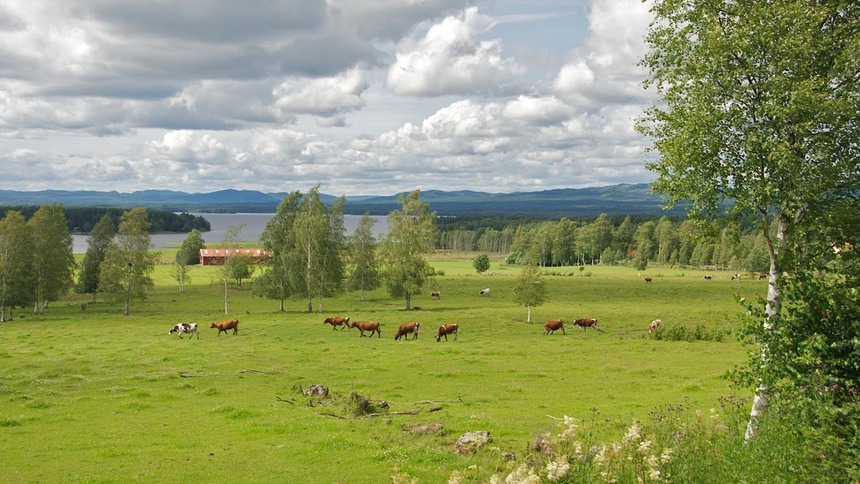
Further south, we found that nothing had really changed, except life was moving a bit more quickly. The towns were pleasant, we wandered and took pictures of the old churches, local architecture and whimsical statues. The forests kept us company along the way.
Soon we found ourselves in the Dalarna region. The Lake Siljan resort area is its dominant feature. This is truly lovely countryside. Bucolic, but still lively; happenings were advertised regularly. We took a small road around Lake Siljan, enjoying the communities along the way.
Leksund was one of our best stops, and the town gets high marks as a great place to spend some time. We wanted to check out the wifi at the local library, and were surprised and delighted to meet the librarian – covered with tattoos! She laughed at our smiles and was altogether charming. The town was full of old American cars – it was Classic Car Week. We saw them absolutely everywhere. What a hoot! Fifties, sixties and seventies, if it came out of Detroit you can find it here in Sweden. Highlights, as ever, were the ’58 - ’59 GM monsters with their swooping fins and acres of chrome; boy do those things look good now. But we saw pretty much everything you can think of, including a fair number of cars and pickups pulling old trailers. If we ever are back in Sweden, this town certainly deserves a second visit.
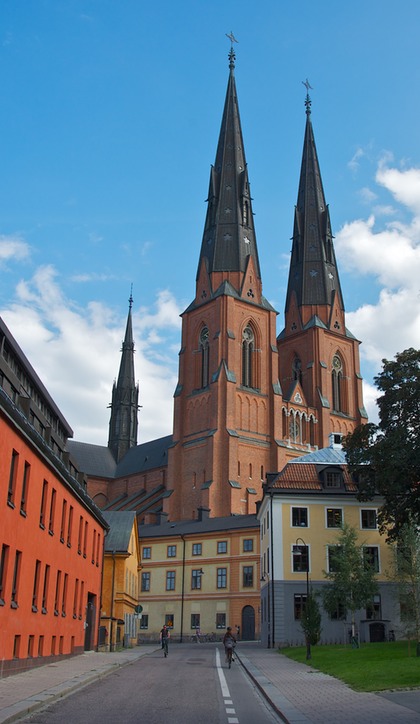
All summer I’d been looking forward to picking berries in the woods. So far, no dice. This season had had a very cool, slow start. But we spent a couple of nights at one of the national parks, and in amongst the ferns and bog plants, the berries were ripe. Delighted, I managed to kneel on a bunch of them and stain my jeans – hors de combat – but who cares! Blueberry pancakes for breakfast – yes!!!
There were other signs we’d arrived in a different part of Sweden. We were at a lower elevation, it was warmer, the grain was ripening in the fields and some hay had already been harvested. It was almost the end of July.
And thus we arrived in Uppsala, north of Stockholm by about 50 miles. I’d been looking forward to visiting this university city, partly because of the Linneaus Gardens there. Having been hearing about Linneaus most of my life, I wanted to see where he had lived here, and the botanical garden that he had used so extensively in his work developing a structured nomenclature for plant and animal species. In the fact, the place wasn’t much, so we merely looked around a bit and went on to enjoy the other delights of the city, which were many.
Uppsala makes a nice place to visit. The students are always enjoyable, for starters; it being a very warm day droves of them were sitting along the edges of the river that runs through town, eating ice cream and chatting away the afternoon. There were regular pedestrian bridges crossing the river, often overrun by bicyclists. Public statues were whimsical (I particularly enjoyed one of a dog on its back, waiting to be scratched) and plentiful. There even were rune stones to be checked out. We’ve now visited three university towns in Sweden: Lund, Östersund, and now Uppsala; each very pleasant, lively, and enjoyable.
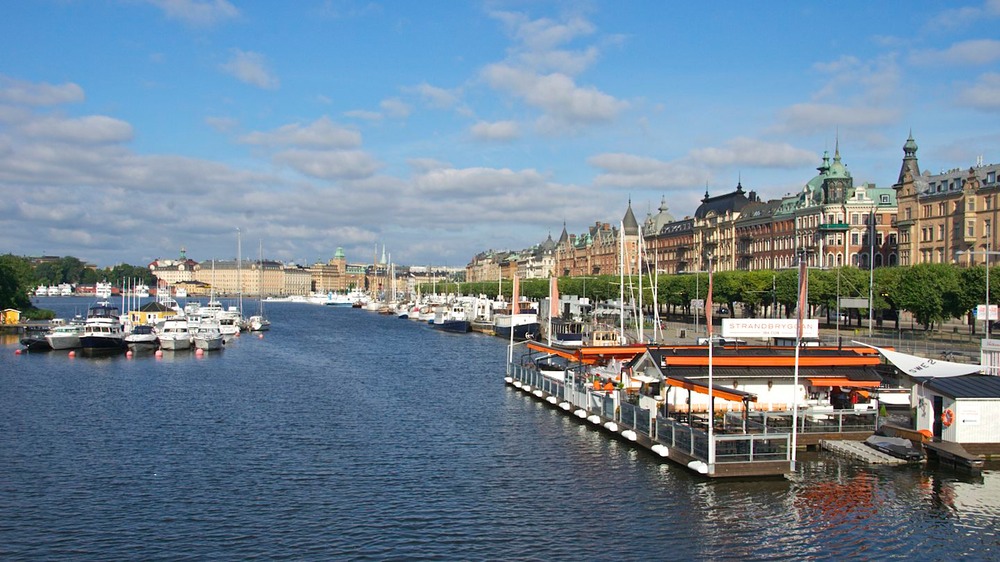
And now we were hot to get to Stockholm, and so on down the road we trotted (well… we know tortugas don’t actually trot, but just ask ole mister hare). And we had a terrific time in the capital city.
We’d been given some really good advice on a place to park, particularly nice as it was free over the weekends. And what a marvelous location it turned out to be! Have you been to Stockholm? If so, think back. We were smack dab along the marina, about halfway between the bridge out to the island where the Vasa Museum is on our left, and then, on the right if you followed along the marina and kept on going, we could walk out to the old town area. It was just super. We had a warm and clear weekend, with balmy nights filled with plenty of moon. We had boats of all sorts docked right in front of us, we could see the 1900’s-era buildings converted to fancy hotels across the water; it was one of our nicest city experiences ever. And we ate it up.
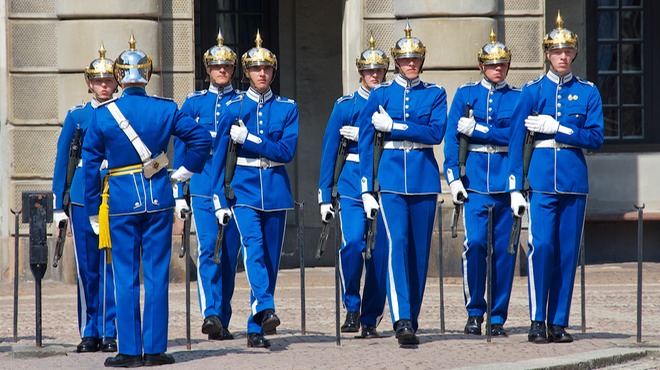
We stayed parked there for two whole days, just enjoying the beautiful city. We saw the old town and some museums the first day, and then walked out to the Vasa Museum early the morning of the second. It was all good, including the changing of the guard at the Palace, the ancient and wonderful Mediterranean museum (photo below), the old churches and markets, you get the picture. We walked and walked. And we saw everything we wanted to see. The Vasa Museum was a highlight, of course. It contains the salvaged ship that sunk almost immediately after its initial launch on August 10, 1628 and was recovered in 1961. It is an amazing story and an amazing museum as well.
The ship is enormous.
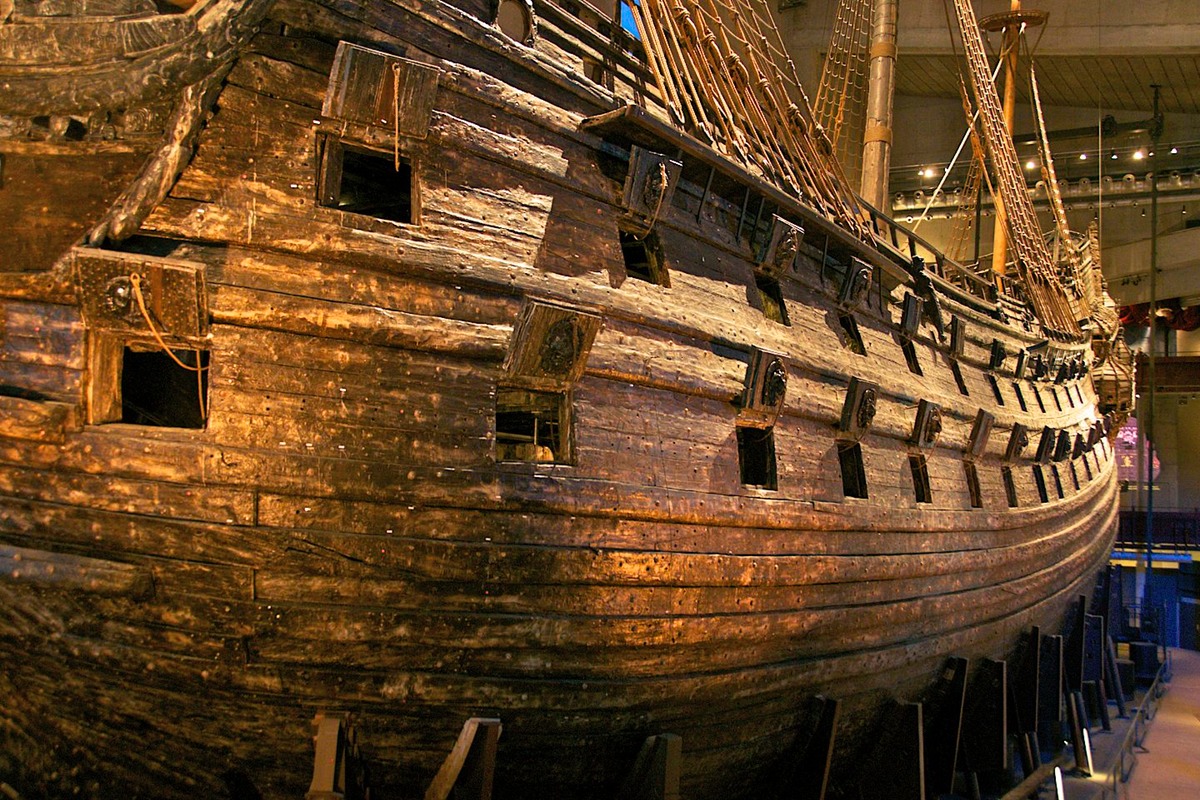
At the time it was the biggest thing ever attempted and as it turned out, they didn’t know what they were doing. Way too tall and narrow and with not nearly enough space for ballast, the whole thing just toppled over in a mild breeze right in Stockholm harbor. Well, we learned that due to the brackish waters of the Baltic sea (not as salty as normal sea water), the worms that normally destroy wooden vessels are not present in the Baltic. The condition of the ship after 333 years under water is simply astounding! Kind of like items buried in bogs that are discovered hundreds and even thousands of years later in remarkable condition; the nature of the Baltic waters is such that the ship survived with details intact and is said to be 95% original. Wow! We’ve shown a bunch of pictures on the photo page but they can only suggest what the experience in the museum is actually like. If you should find yourselves in Stockholm, you do not want to miss this museum. We seldom share any technical information about our photos, but should you be interested, the Vasa Museum is a very dark environment, presumably to preserve the ship. This photo was handheld, shot at ISO 1600 with a one fifth of a second exposure at f 3.8, no flash of course; other shots on the photo page were done as high as ISO 3200. Our hats are off to Nikon for the technology that makes these photos possible. (Nikon D 7000 and 18-200mm VR zoom lens)
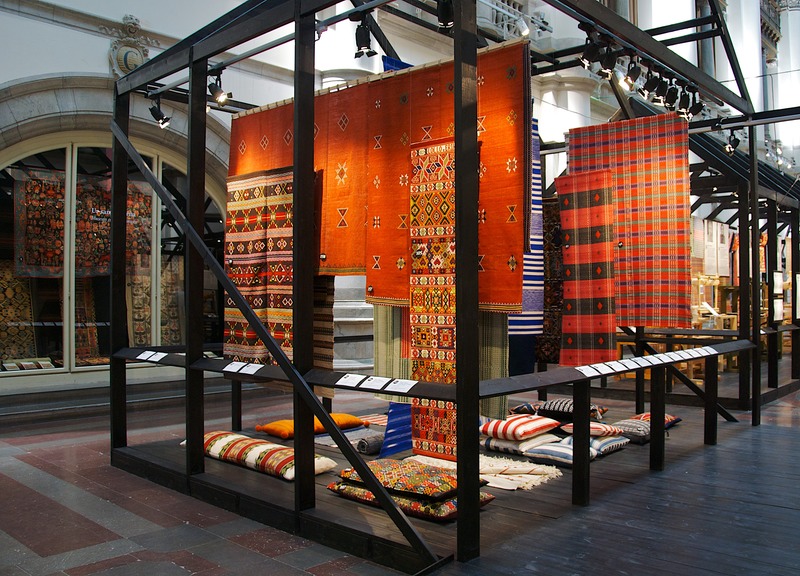
Herself spent a couple of hours in the Nordiska Museum, which had extensive displays of how Sweden used to be, and lots about crafts and everyday life. I really enjoyed it, and was able to see a very nice, if brief display of Sámi crafts. And… the museum is in a really cool old building. A big success.
Both days we stopped to get lunch while wandering, each time having a chance to chat with “foreign” locals. One was from Iran, the other Iraq; one operated a small pizza place while the other had a stand serving hot dogs and sausages. Each volunteered to us that they were Christian, not Muslim, and had left their home in order to get away from all the badness and persecution. They harbored no bad feelings toward us as Americans; they just wanted it all to stop. We were glad to have had the chance to meet each of them; both men were in their 30s and had been in Sweden for about ten years.
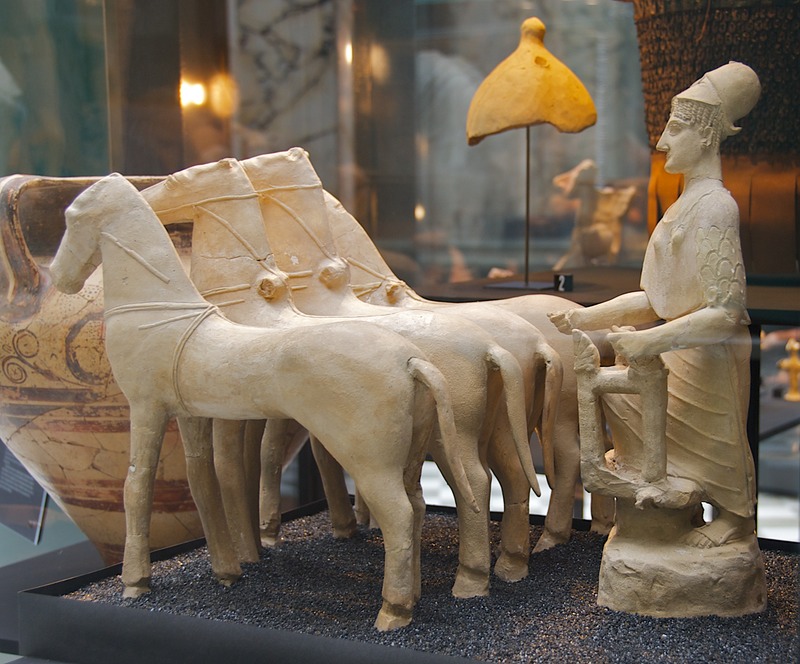
By Sunday evening we were exhausted, and also needed to move from our site by midnight – the sweepers were coming through. It was time anyway. We had booked a ferry crossing to Finland for a couple of days hence, and still had one last place to visit.
We’d located a motorcycle museum, the MC Collection, in Sollentuna, a suburb of Stockholm that wasn’t far away. So we trekked on up there, and Rick had a marvelous time wandering at will. We were able to park up in their lot, so we hung out a bit while Rick enjoyed himself. It’s a very nice spot and well worth a visit if you are in Sweden. About 120 machines, heavily weighted toward American bikes between 1905-1940 with lots of racing models in the mix. Upstairs is a small group of more modern bikes, but the reason for coming is the vintage collection. The bikes are very clean, the lighting and the printed information are both good, and the whole experience is low key and enjoyable. Photos can be seen at motor-museums.com.
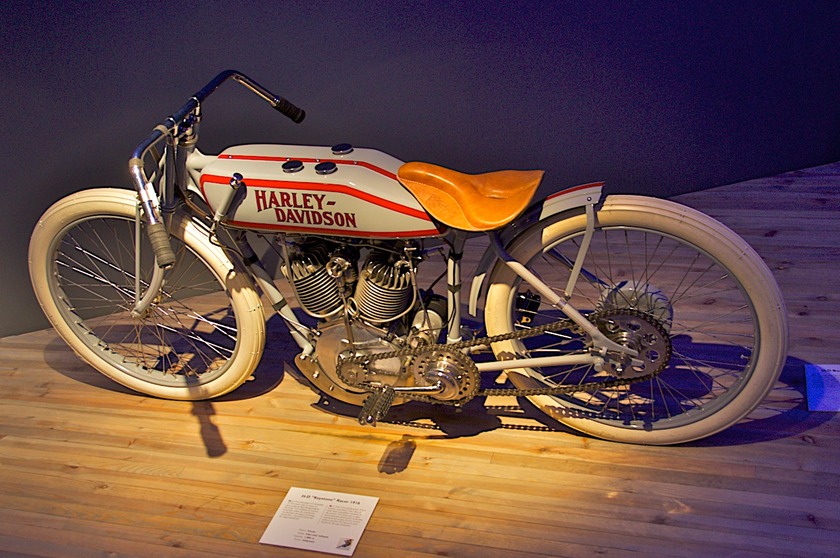
We also wanted to catch some wifi before leaving the country; we’d been having trouble at our usual spots (libraries and McD’s when necessary) – the online servers didn’t want to recognize us, etc. Getting somewhat desperate, we stopped at a mall – and got lucky. We’d forgotten how often we’d ended up at malls in Central and South America – frequently the only wifi service in town. After becoming current again, we headed back into Stockholm, spent our last Swedish night at the port, and took the ferry early the next morning.
The ride was long – 11 hours – but uneventful. Ferry travel these days ain’t what it used to be. The companies all seem to be contesting for “most cruise-like voyage.” There are very few, if any, quiet places to just sit and be, but plenty of restaurants and bars with live music just everywhere, even a karaoke bar would you believe. A note about the karaoke bar: the songs (we think) were all in Finnish; the only one we could recognize was “The House of the Rising Sun.” Not for the faint of heart! This is what finally drove us from what had been our quiet corner and thrust us out among the multitudes.
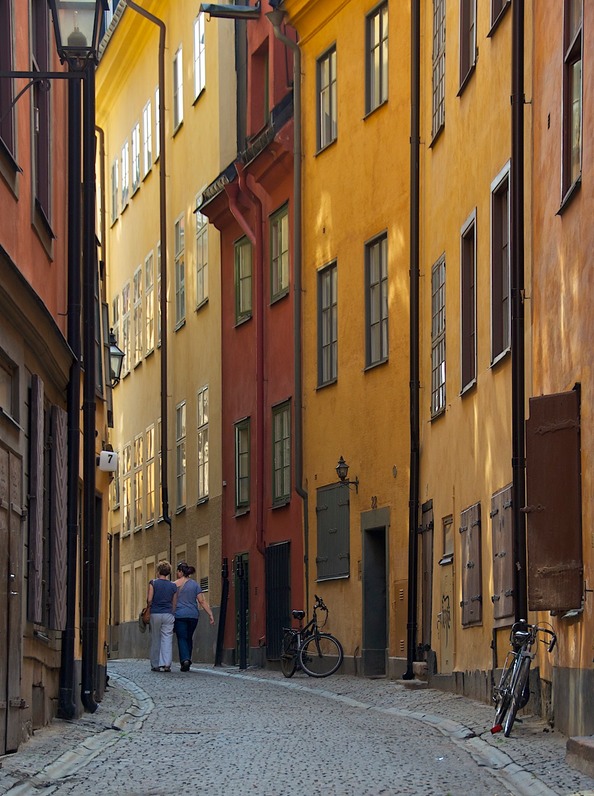
It was a lovely day, however, and we enjoyed ourselves. We knew that Stockholm was surrounded by islands, but not having looked closely at a map, we were surprised at how deeply Stockholm sat tucked up into its island archipelago. We spent hours maneuvering among the small islands before reaching the open sea. And then, after only a couple of hours of unencumbered water, we made a brief stop at Mariehamm, the capital of the Åland Islands. From there on, we were back to being surrounded by islands all the rest of the way. We docked in Turku, Finland, west of Helsinki, and it also was at the mouth of a long channel through small green lumps of land! But it all was lovely to watch, and the hours passed pleasantly. The overall journey isn’t all that far but the ship has to move slowly as it wends its way through the islands.
In the end, we’d really enjoyed our time in Sweden. It’s not as spectacular as Norway, its neighbor to the west that justifiably gets most of the press, but it has lovely areas filled with charming towns and nice people. Often, we’ve heard, “Everything north of Stockholm is just forest”, but we would argue that point. There is a lot to see and enjoy throughout Sweden.
We hopped off the ferry in Turku, and did our best MacArthur imitation as we returned to Finland. (OK, now you’re getting picky… we know that tortugas don’t hop either.)
The area we know as Finland used to be ruled by Sweden, and the southwest is very Swedish: the architecture, the people who are settled there, names of things, they all reflect the many years of Swedish dominance. Also, you may remember that we’ve commented that depending on where you are in a country, the road signs will reflect the languages spoken in the area. Here, they were in Swedish first, followed by Finnish. Why? Because Turku had been the Swedish capital. (When the Russians conquered the Swedes, they moved the capital further east, to a small village called Helsinki.) Finland only became independent from their looming neighbors in 1917.
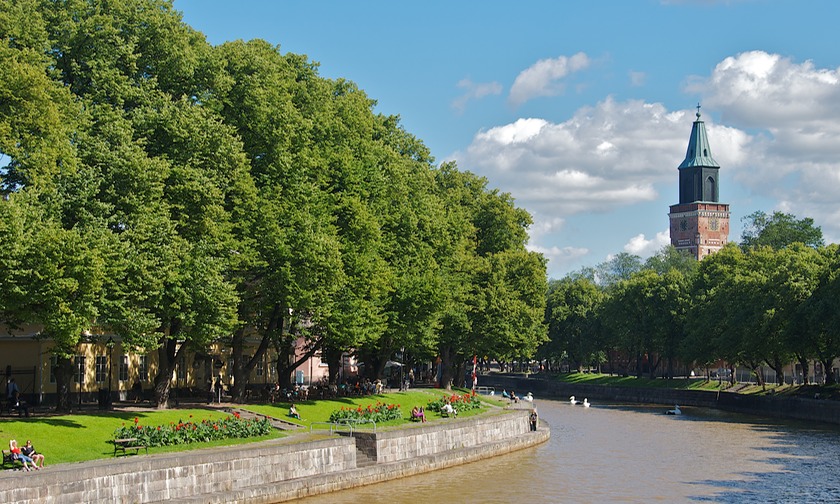
Turku is a very nice place to visit, in a pretty setting on both sides of the river channel that runs through the city. The old cathedral and public buildings are quite enjoyable, and we wandered around enjoying the charming atmosphere along the canal, particularly the international market – lots of French food, which surprised us.We found an enormous block of cheddar cheese, which we promptly purchased despite its caviar-like price– it should see us through to Bulgaria (where we know we can get more)!
The Jean Sibelius museum is here, with an excellent collection of old musical instruments, photos of the man and his family, and good information on his life and accomplishments, all with his music in the air – most famously Finlandia. It was a very nice visit. Other museums were enticing, but finally we moved on, heading into the countryside and the old historic town of Rauma.
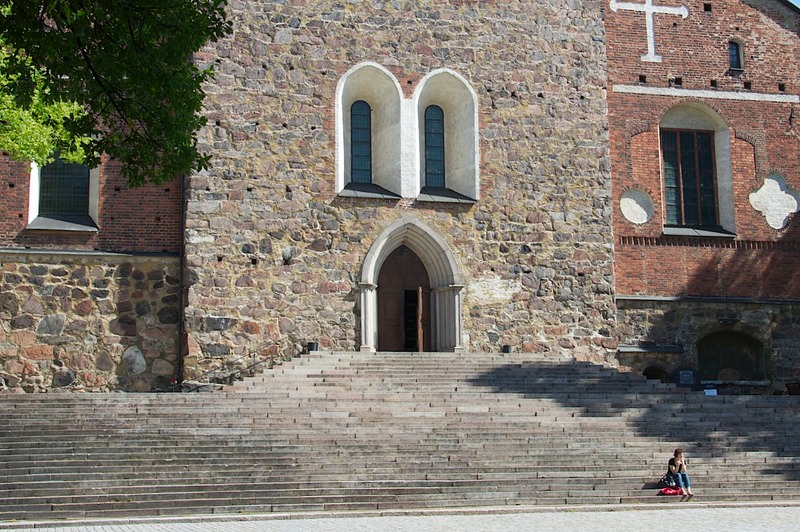
Leaving the city, we were immediately back into the familiar mixed forests interspersed with fields. There were commercial strawberry fields now, mixed with large plantings of wheat and other grains. The area is rather bland, but certainly enjoyable. The wildflowers are now more mature, as we move ever closer to late summer. It was warm and pleasant, although overcast. All summer we’ve felt we were never far from rain.
Rauma, actually the old town of Vanha Rauma, is an area of preserved wooden houses that date back to the 1800s. It was nice, but as the town has been “discovered” it has become more cutesy and filled with antique shops and cafes. It didn’t hold us long. However, it was Saturday morning, and there was a very interesting produce market underway in a small square. We were able to buy some splendid smoked salmon and some killer strawberries just out of the field. Oh, and fresh peas in their pods, a national passion; you can buy them at stands just about everywhere.
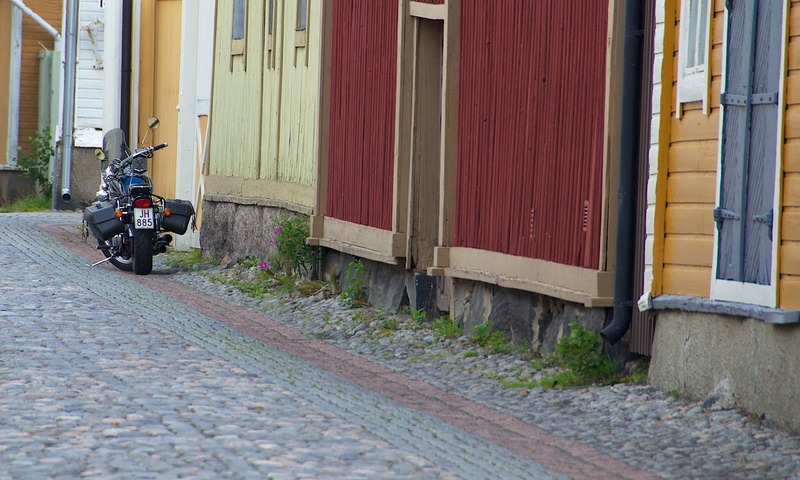
Even better, I was able to find someone to chat with about the various kinds of potatoes she had for sale. In the supermarkets in Finland there are far more kinds of potatoes to chose from than I’d seen before, with no information. They are fresh, dirty, and in unmarked bins. The purchasers are pawing through, and are obviously enjoying the variety available. They carefully pick out 6 of this kind, a dozen of that, etc. I just stand there – clueless. So she explained some of their qualities – for soup, for baking, for this or that. We had fun together. And I bought some beauties.
Our plan for now was to circle around in the countryside west of Helsinki, slowly moving toward the capital and intending to arrive there in a few more days. We had a friend we were going to meet there – a Scottish friend, would you believe – in town visiting her son – and we’d organized a day together to see the big city.
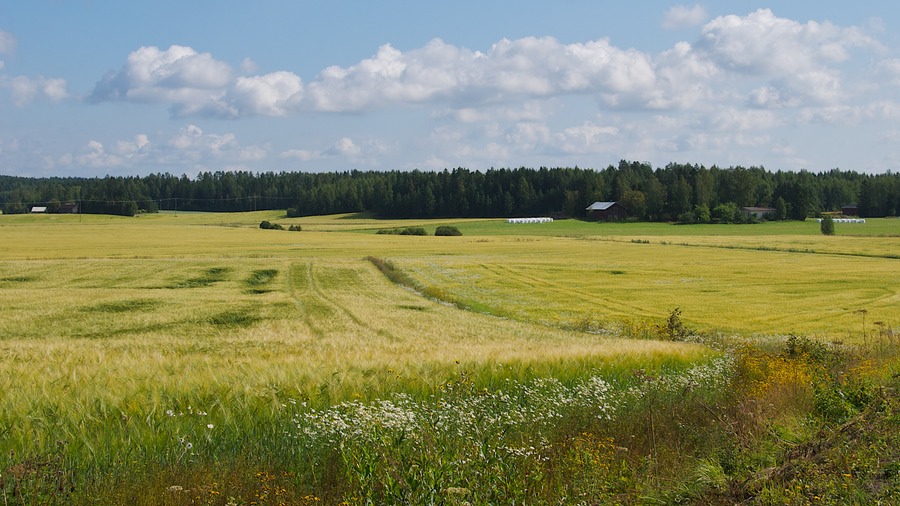
In the meantime we headed into the woods, towards a national park. Finland has tons of them, scattered around in the woods, usually near a lake. They are small and quite delightful, mostly undeveloped, and attract hikers and birders. There tends to be a quiet parking area along one edge of the park, great for hanging out. There are boardwalks through the bogs and low areas (Finland is full of low area) and towers for looking at the wildlife. Bogs are cool, and the berries are ripening, along with the mushrooms. When we were in Alaska and the Northwest Territories I had bought a book on edible berries. A very similar area to this part of Scandinavia; so I studied up and knew a bit about what would be edible.
We visited several of these small parks in southern Finland, and enjoyed them all. Yes, there were mosquitoes, but they were never really a problem; bug stuff kept them at bay. (By the way, räkkä is the Sámi word for blood-sucking insects.) I watched the cranberries coming along, but sadly they never ripened for me. I walked around, enjoying the quiet and the views, rarely seeing anyone else, and never once falling off the tiny, single log boards they gave me to walk on. Delightful interludes.
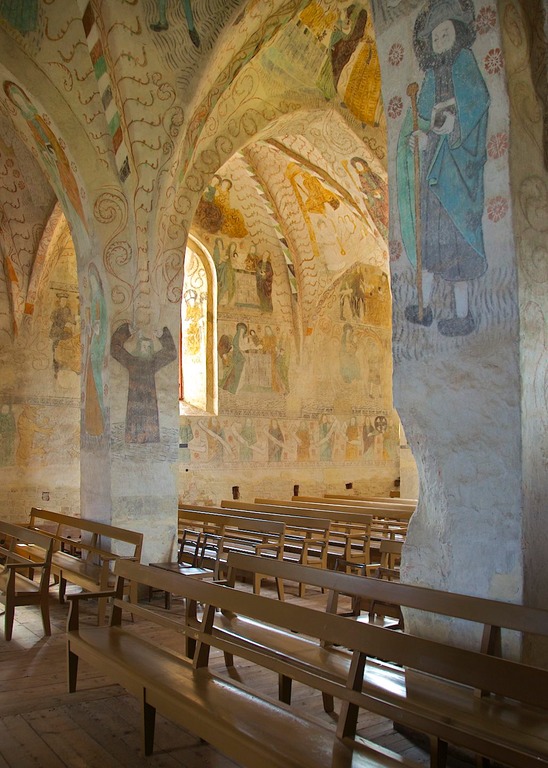
But lest I get bogged down, we’ll move on. (Or mired; they also call them “mires.”) We stopped in Hattula, not-even-a-hamlet, to see the terrific medieval church there. These ancient churches are off in little corners of the country, not exactly ignored, but certainly off the tourist trail. The “keeper” unlocked the door for us with this enormous key and turned us loose.The church was a charmer, filled with frescoes – they were just everywhere on the walls. It was mind-boggling. Wooden carved items and a small box sitting on a chair had plaques beside them dating them to 1400. You get the picture. We loved it.
We spent the night in their small parking lot, and then the next day we drove into Helsinki…and right back into the modern world. We were able to negotiate the traffic well enough, partly because they were all leaving the city and we were coming in. We hooked up with Frances and her son, Jason, at his apartment, where we spent a really nice evening. It was quite an international event. Jason had some friends over; they were two Americans and a Finn; Jason and his mother are, of course, from Scotland. So we had quite a gab, and curry for dinner (to add to the international-ness of it all). We learned about what expats in the area do (teach ESL), where they go for fun (Estonia!), how bad the weather in Helsinki really is, all the good stuff.
Speaking of weather, the locals were all complaining about how lousy the summer weather had been, and how you couldn’t rely on anything past the first of August (which it now was). Helsinki has this fun classic car show the first Friday of each summer month. June and July get a terrific participation but everyone knows that by August attendance will be way down because summer is beginning to shut down and the owners of the cars won’t bring them out in the rain. How’s that for a weather indicator! Helsinki is roughly on the same parallel (the 60th) as the southern boundary of the Yukon and Northwest Territories way, way up in Canada; you just gotta love the Baltics and their cold weather along the coasts. It got down to 39 degrees last night.
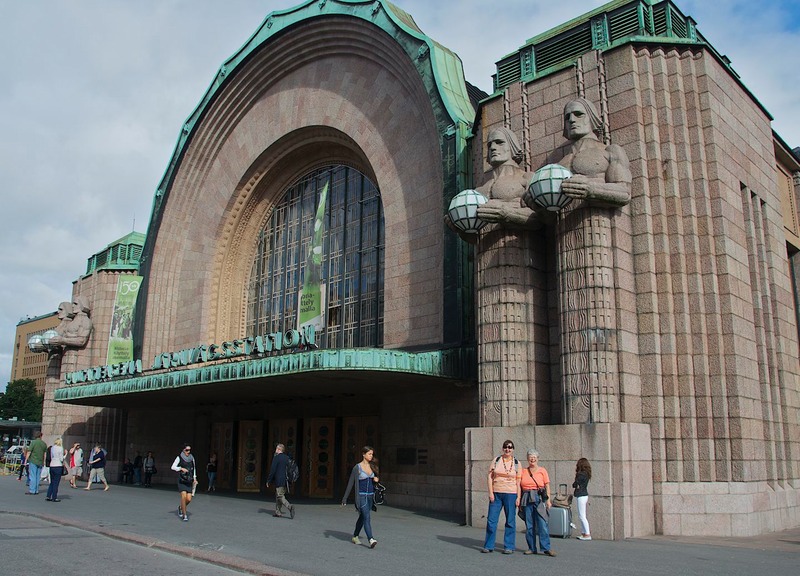
Then we did Helsinki in a day. We knew we’d be back to the city later in the month, so we wanted to go see things that would be of interest to all three of us. And we had a great time. It was a nice day, with just a hint of rain (that never fell), Frances is lots of fun to be with, and she walked our socks off. We started at the old train station, with its iconic statues outside the main entrance; to see them in person was a real treat for me. We visited the food markets and picked out lunch from the local wares, which we then took on the ferry out to Suomenlinna to see the fortress that once guarded the city and eat our lunch. It was great wandering around out on this island, checking out the gun emplacements and the views across the water.
Back on the Helsinki mainland, we visited the Orthodox church, which sadly was a real disappointment. It was all very prettified, huge, seemed new, and couldn’t hold a candle to the lovely, intimate Orthodox churches we had seen in Serbia and Bulgaria. Ditto for the grand Lutheran cathedral unfortunately. As mentioned earlier, Helsinki wasn’t much in the old days, just a village really, and it pretty much burned to the ground in 1809. Due to its grand harbor, Peter the Great named it the capital a few years later and the entire downtown was rebuilt all at once and thus all in the same style. As a result, the city lacks some of the historic charm of the other capitals we’ve visited.
We continued on our way, hopping on and off trams, making a circle tour of some of the outlying city sights, very much enjoying the chance to see parks and interesting buildings and people-watch. We dragged home, exhausted, and after hugs and good-bys, moved on a short ways out of the city, where we found a quiet spot for the night next to a marsh (almost as good as a bog).
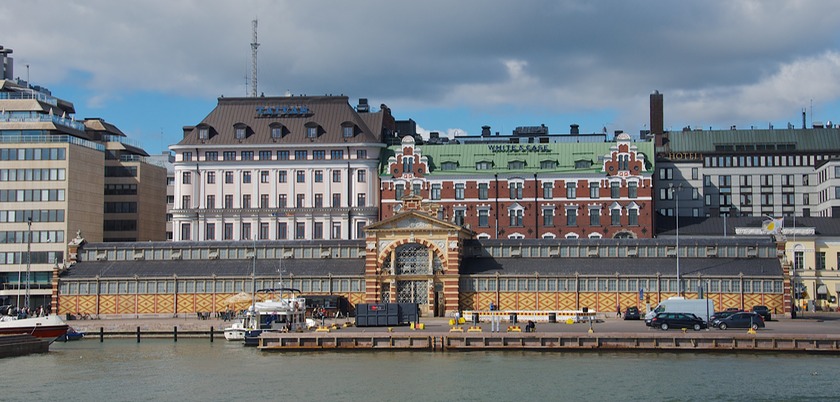
We had arranged to have our mail sent to us at Jason’s place, but only part of it had arrived (what else is new?). So our plan was to spend about a week touring in the area known as the Lake District, concentrating particularly on the part that rubs up against the Russian border (we just can’t leave those guys alone).
Modern Finland is represented by Helsinki and the surrounding 100 miles or so. You get beyond that, and you step back into a quieter time. The fields are productive, the forests full of lovely birches and Scotch pines, and now mountain ash with its red berries; the lakes are numerous and peaceful. Bucolic is probably not a word of Finnish origins, but it sure could be.
So we left the city behind and headed into the hinterland again, this time towards the northeast – into the Karelian District. All of rural Finland is filled with small jewels to be discovered, and East Karelia is home to some of the best. We wandered the area for several days, often skirting the Russian border. We were reminded of the fellow in northern Finland who had commented that Finland wasn’t part of Scandinavia. Finland and Russia share a long border, their languages have common roots, and there are many Russians living in this part of Finland. The Karelian area, along the border, has changed hands several times just in the last 100 years.
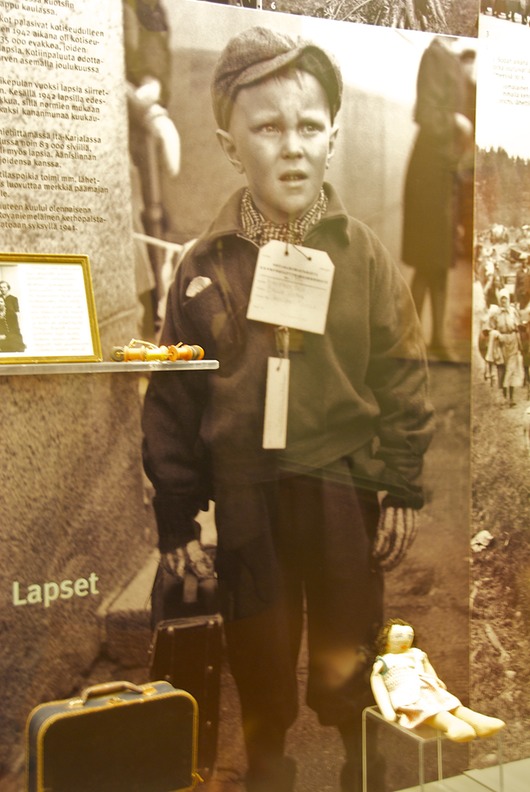
Summer is beginning to wind down a little here in the countryside. The fireweed is finishing up and it’s only August 11th. The wildflowers are mature and fading. The combines are beginning to work on the hay. Stopping to visit a country church, we were shown around by a college student who said school would be starting in a couple of days. We had actually arrived on the very last day the church was open to visitors for the summer.
We visited the war museum in Mikkeli, learning more about WWII as it was fought in this country. Earlier we had learned that Finland had repulsed the Soviets in the winter of 1939-40, the Winter War. Now we read that the government had, in reality, sued for peace. Whatever. The years that followed were an uneasy time of quiet called The Continuation War. The Finns tried to find anyone who would help them keep the Russians out and ultimately had to form an uneasy alliance with the Germans who promptly occupied the country.
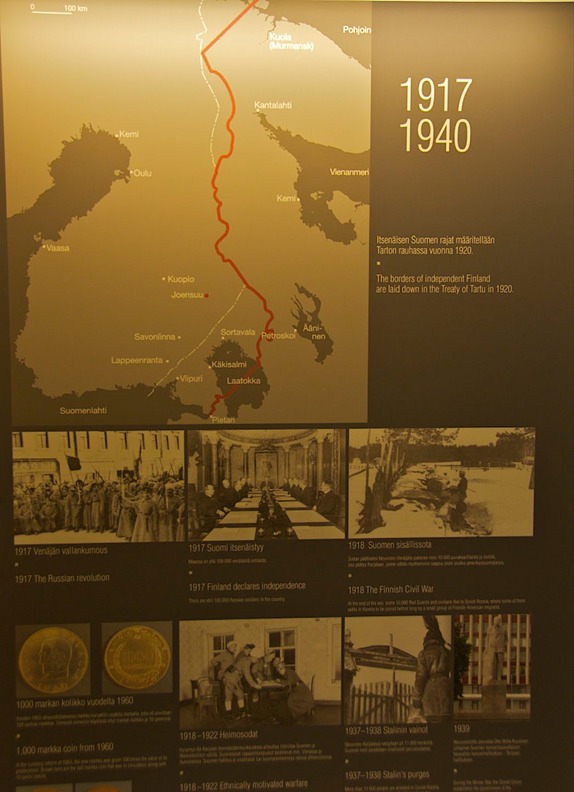
As time went on of course, the Russians did invade and the Germans were forced out. In the bargaining and trade-offs made in the war-ending treaties, a large section of East Karelia, the Karelian Isthmus, was handed back to Russia. Finland maintained its freedom and independent status, but at a price – in total it lost roughly 10% of its land to border adjustments.
In Joensuu, a few days later, at the North Karelian Museum, we learned even more. There was a poignant display on the plight of the Karelians. First, during the Winter War, in 1939 - 40, they were forced out of their homes by the Russians. A few months later, treaties allowed them to return. Then, in 1944, they were forced out again, this time for good, given a few hours to gather belongings while the Russians stood there waiting for them to vacate. It was all very sad,
This museum also gave us the best explanation we’ve seen about this Russian-Finnish border and how it has changed over the years. There were excellent diagrams, and background history to explain why the border changed. This is an excellent, unsung museum, with a lot of good information and displays; it’s a little disorganized (we’ve found this to be true throughout Finland), but much of the material is in English (among other languages). We were glad we’d found it.
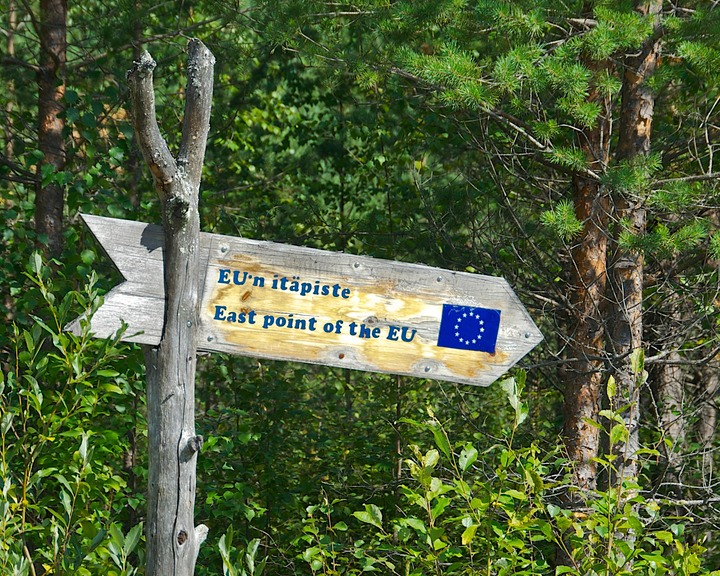
One of our goals while in the area was to go to Hattuvaara, very close to the border. From this tiny, tiny mini-hamlet, you take a gravel road due east, right to the border. It used to be you had to apply for permission to make this trip, but since 2010 it has been easy. You travel along between fences with yellow markings on them, making it quite clear you must stay on the road. After about 10 miles, at the end, there is a small parking area and then a walking path (between blue ropes with signs clearly indicating you must stay on the path) down to the river that forms the boundary. It’s a beautiful spot. You can see out a short distance across the water to where there are posts on a small island; this is the actual border. This is also the easternmost point in the European Union… well almost. It’s the easternmost point in the ‘continental’ EU; Cypress is further east. Anyway, a significant spot.
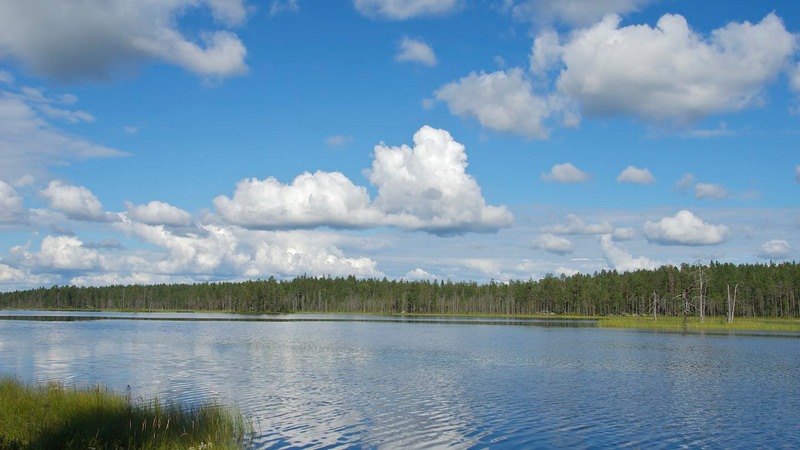
The area was quiet and we had it to ourselves. There are places not far back from the border where there are camping huts, and a few cabins, and we did see a young couple with heavy backpacks that were heading in that direction. This is a very solemn place and it had a real impact on us; not sure we would have wanted to spend the night. It all seemed a bit tense with the signs and colored markers and all. The Russians always have and still do take their borders very seriously.
Walking back to the truck, however, I did see a goodly supply of blueberries at hand, so I came back with a container and picked a bunch. I made sure I stayed within the blue ropes. Not worth getting shot at, or even harassed, although we had seen no sign of any guards.
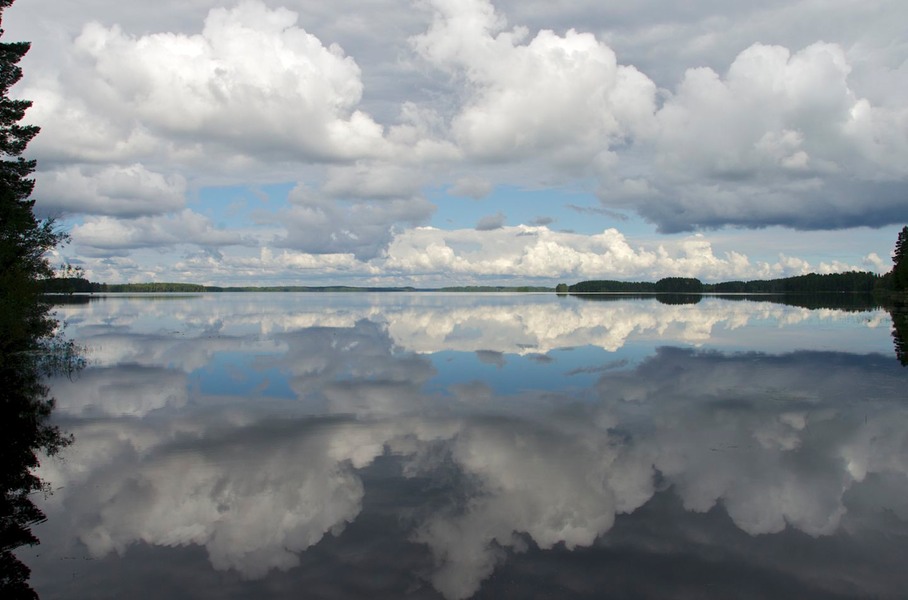
Starting our swing back southwest toward the capital, we had two more places we wanted to visit. The first was the Valmo Orthodox Monastery, not far west of Joensuu. We find we aren’t overly interested in Russian icons, which is what this monastery is best known for, but we always enjoy the rural, restful settings. Valmo is a well known retreat, and the location is incredibly beautiful, on a lake with lots of trees and seclusion. The monastery and a nearby convent were both victims of the change in borders during the war as they both relocated here from much further east. We spent the night, parked across the water from the mostly hidden buildings, enjoying the ambiance – and the lovely bells that rang out regularly. It had been a long time since we’d heard church bells in the evening; these were particularly nice. It was a warm night, the moon was up, and we thoroughly enjoyed the experience.
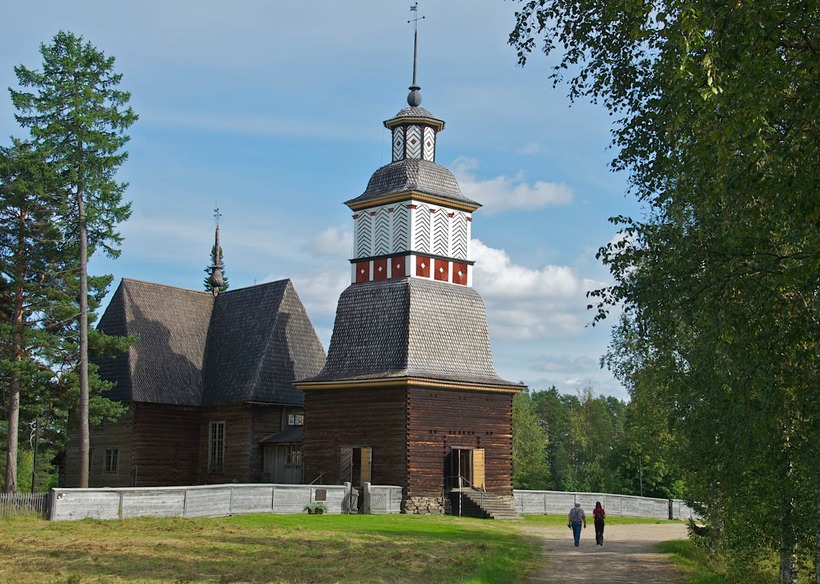
The next day we traveled further west, to the tiny spot on the map known as Petäjävesi, on the outskirts of Jyväskylä (to throw in some more of those complicated names for you). Again, a wonderful church, this one the oldest wooden church in Finland, built in 1764. It’s a World Heritage Site, and a great one. We had a good time, and spent quite awhile there, once again staying in the parking lot for the night.
The next day we trucked back down the hill the 150 miles or so to Helsinki. We had arranged to pick up the rest of the mail and we had made our ferry reservation for Estonia, so we needed to get on our way.We stopped and chatted with Jason for a few moments, picked up our package, and headed into the big city again…back into the modern world after a delightful foray in the lake district. Rural Finland seems like a country apart.
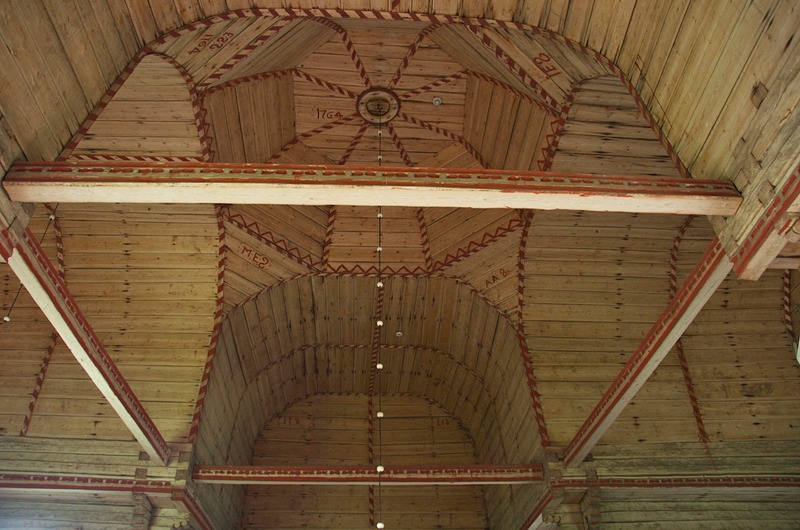
But Helsinki welcomed us, we found our way (with difficulty) through the infamously nasty traffic to the (continually) under re-construction port area and to the ferry terminal, spent the night in a parking area nearby, and climbed on board, ready for new adventures.
During our evening in the city, we thought a bit about our time in Scandinavia. It’s been a great summer, filled with beauty and new things to learn. It’s easy for us to understand why European travelers make the trek up here repeatedly to see more of the far north. We’ve spent a total of 86 days, gone through about 6,500 miles worth of expensive fuel, spent three weeks between sun sets, crossed the arctic circle four times and struggled with a variety of different and difficult languages. But it’s been great. As you may notice in our photos, the air is the clearest we have ever seen with virtually no haze at all; absolutely sparkling. The area’s history is really interesting; who knew that first Denmark and later Sweden ruled most of the area centuries ago, to the point that the border the Russians and Finns fought over in WWII was much the same as the border Sweden and Russia fought over three hundred years ago? It’s a wonderful, albeit expensive, area in which to travel.
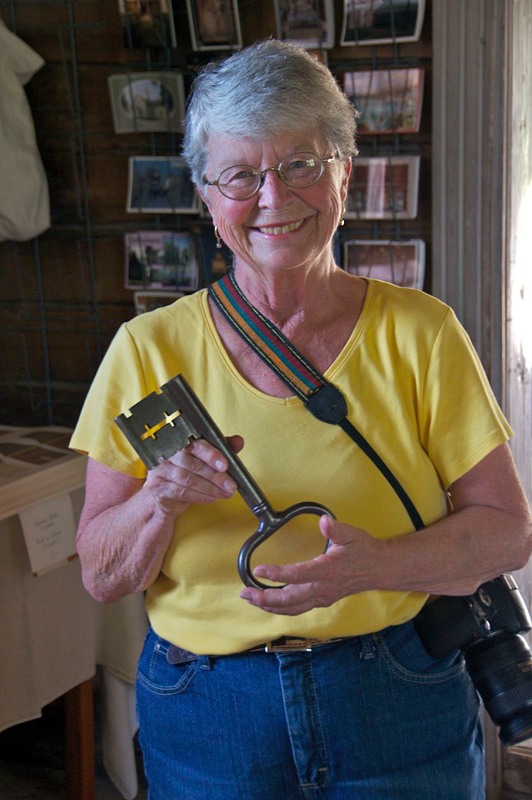
We met some wonderful people, sometimes able to speak our language and sometimes just communicating in other ways. One special older fellow was admiring the map on the side of the Tiger when we came out of the market. Not a word of common language between us, but first he said WOW!, and then calmly doffed his cap and bowed to us, acknowledging our prowess, in his eyes at least, as world travelers. That was a neat encounter. And then all the helpful folks we met in tourist offices and libraries; endlessly patient and happy to help us in anyway they could. The people alone are a good reason to visit Scandinavia.
There are commonalities throughout Scandinavia but plenty of differences as well. Norway has the best of the spectacular scenic beauty, while Denmark, Sweden and Finland are all lovely in quieter ways. All four countries seem like they would be great places to live; well, aside from the long dark winters. The people of Denmark, Norway and Sweden “look” a lot alike, while the Finns are clearly from different stock. Many, many of the place names throughout the region include references to water, which is not surprising, given all the lakes and streams and waterfalls. The languages of all four countries are different, but to the unknowing eye and ear can seem more similar than they actually are. Danish, Norwegian and Swedish actually are a lot alike, while Finnish has different origins and sounds different when spoken, even to our untrained ears. By the way, we think Finnish sounds and looks a lot like the Hawaiian language – all those vowels and ‘Ks’! One common thread in the entire area was the quality and frequency of the libraries. They often were quite new, almost all had excellent internet access, and they welcomed our presence.
But enough, it was time for bed; the Baltic States awaited us just across the water. And we were ready! Estonia – here we come!
Farvel, (Denmark), Adjø (Norway), Hejdå (Sweden), Näkemiin (Finland);
Goodbye from us, and Adios from good old hop, skip and jump La Tortuga.
Click to see more photos from Central Sweden or Southern Finland